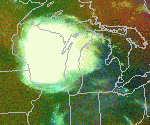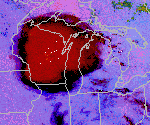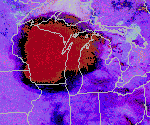Red, Green, Blue (RGB) Product Details
RESEARCH DETAILS

MODIS Air Mass
The MODIS "Air Mass" RGB composite uses a total of four infrared channels to characterize moisture, cloud cover, and synoptic-scale features associated with air masses. Red shades are generated by differencing bands 27 and 28 (6.7 µm and 7.2 µm), greens difference bands 30 and 31 (9.7 µm and 11.0 µm), and blue is produced by an inversion of the band 27 (6.7 µm) brightness temperature. Temperature differences in each channel pairing or single channel brightness temperature are constrained and enhanced to develop color combinations relevant to air mass characterization. EUMETSAT developed the air mass composite to improve detection of rapid cyclogenesis, jet streaks, and potential vorticity anomalies. In the final color combination, warm air masses are indicated in shades of green, while colder air masses are indicated in deep shades of blue and purple. Jet streaks and regions of subsidence are identified as red shades. EUMETSAT provides additional training references at the following web link: http://oiswww.eumetsat.org/IPPS/html/bin/guides/msg_rgb_airmass.ppt
RESEARCH DETAILS

MODIS Dust
The MODIS "Dust" RGB uses five infrared channels and their differences to identify dust plumes that are being lofted into the lower atmosphere. Red shades relate to the difference in bands 32 and 31 (11.7 and 10.7 µm), green shades relate to differences in bands 31 and 29 (10.7 µm and 8.4 µm), and the blue coloring relates to brightness temperatures in band 31 (10.7 µm). The RGB composite is designed to identify dust plumes in a bright pink color during daytime imagery, and a darker pink to purple shade in nighttime imagery, due to the contrast in surface and low level temperatures that occur in the diurnal cycle. Cold, thick and high level clouds will also appear as dark reds, while thin cirrus and contrails will appear in shades of green to black depending upon the background surface. The dust RGB is primarily useful in identifying blown dust associated with dust storms and comparable events in desert or dry areas where these events are more frequent.
RESEARCH DETAILS

MODIS Nighttime Microphysics
The MODIS "Nighttime Microphysics" or "Fog" RGB uses a total of three infrared channels to identify low clouds and fog, low stratus, and thin cirrus. Red shades are related to the difference in bands 32 and 31 (11.7 µm and 10.7 µm), green shades relate to the difference in bands 31 and 29 (11.7 µm and 8.4 µm), and the blue shades relate to the brightness temperature in band 31. The RGB composite recipe was developed by EUMETSAT to provide a cloud analysis, detection of fog, contrails, and snow. The composite is designed to characterize fog with a light green color. The actual shade of the fog color will depend upon the depth of the fog layer and the temperature contrast between the cloud top and the underlying surface. As the surface temperature warms, the color of fog in the composite will transition from a light green to a light blue, due to the inclusion of the infrared channel assigned to the blue color. Deep convective clouds appear in deep reds. High level ice clouds, such as cirrus, appear in dark shades of blue.

